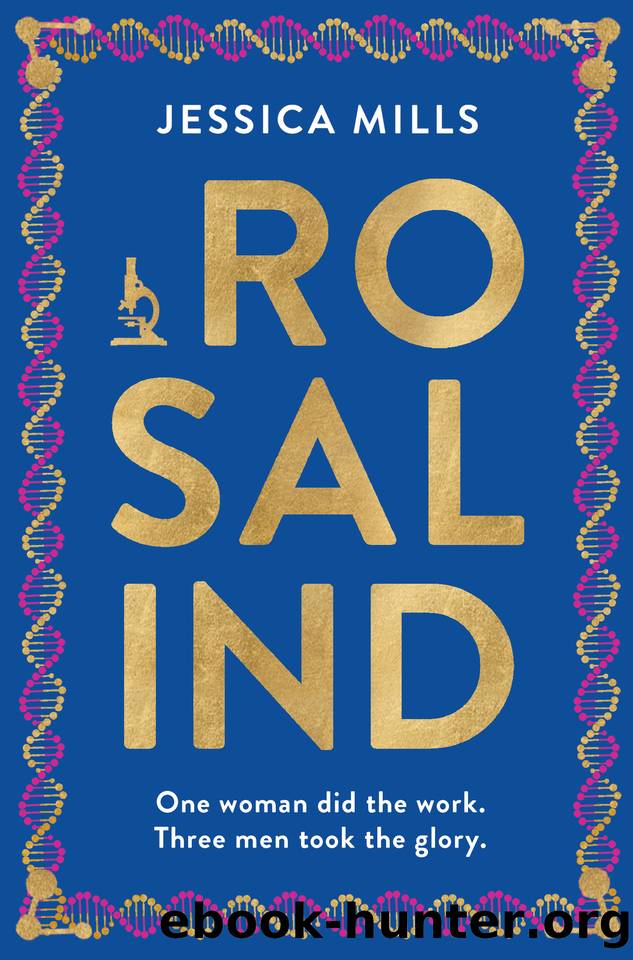Rosalind by Jessica Mills

Author:Jessica Mills [Mills, Jessica]
Language: eng
Format: epub
Publisher: Legend Press
Published: 2024-02-02T00:00:00+00:00
| 24 |
Crystalline
Kingâs College London, The Strand, 1 May 1952
That morning, the mahogany box where the tabulations for our calculations are stored ricochets off a table leg in the room next to my office and falls upside down on the floor. Itâs the era of automation, but still we arenât able to produce complex atomic vector maps at the click of a button. Bessel functions, which we can use to plot the atomic distances in a molecule, are only tabulated on the paper system up to forty microns. We must slowly and precisely do all the calculations by hand to determine the distance between the atoms.
The scores of paper Beevers-Lipson strips that are kept in the mahogany box are dispersed unevenly on the ground and are now lying face down in the puddle of water from the leaking roof, absorbing moisture from the leak like Litmus strips. The stagnant pool is gradually fading the printed trigonometric expressions on the paper pieces, which are essential to sine and cosine arithmetic. Without them, a dayâs sums will take a week.
Raymond is standing by the box with a concerned look on his face.
âThat will put us back by at least a day,â he says, waving at the mess.
âHurry and pick them up before the ink fades,â I urge him.
âThe darn things are so fiddly,â he complains while getting down on his knees to help rescue the strips.
âWhy donât you take the slides to the dark room, if itâs still open, to develop the negatives?â I suggest once weâve collected the limp paper pieces and spread them on the windowsill to dry.
Heâs delighted at any excuse to avoid my acrimony. When heâs gone, I spread the existing list of calculations out onto the laboratory bench and peer at them to judge what is missing. They are the fruits of our attempts so far to plot out the position of the atoms in DNA.
Doing the calculations by hand isnât the fastest way to conclude a theory. We are working blind; starting from the numbers, and extrapolating outwards, with no map to guide us other than the X-rays themselves. But working backwards from a model would only leave room for error, it would be guesswork and we would have no proof that it was right.
However, little by little, with consistent effort, the truth is sure to reveal itself from the numbers. Numbers are firm and immutable. I trust them more than feelings. They donât bend or twist, like emotions. Emotions flit and curl and seep from the seams. They are fallible in ways that numbers arenât. Numbers hold their weight. They blend and subtract from others in a logical and hermetic world thatâs reassuringly predictable. Lifeâs secrets are hidden in the data.
âDr Franklin,â Raymond says minutes later.
âCan it wait?â
âItâs the filament. Itâs burned.â
âWhat do you mean itâs burned?â
âItâs burned through, Dr Franklin.â
The X-ray filament had incinerated ten days ago during one long photographic exposure. The filaments have an average lifespan of just 250 hours, it turns out.
Download
This site does not store any files on its server. We only index and link to content provided by other sites. Please contact the content providers to delete copyright contents if any and email us, we'll remove relevant links or contents immediately.
The Spy by Paulo Coelho(1556)
The Covenant of Water by Abraham Verghese(1543)
Cain by Jose Saramago(1494)
La Catedral del Mar by Ildefonso Falcones(1131)
The Prince: Jonathan by Francine Rivers(1124)
Bridge to Haven by Francine Rivers(1117)
The August Few Book One: Amygdala by Sam Fennah(1078)
La Catedral del Mar by ILDEFONSO FALCONES(1049)
La dama azul by Sierra Javier(1017)
Cain by Saramago José(1016)
La dama azul(v.1) by Javier Sierra(1012)
A Proper Pursuit by Lynn Austin(1004)
Quo Vadis: A Narrative of the Time of Nero (World Classics) by Henryk Sienkiewicz(987)
Devil Water by Anya Seton(976)
Sons of Encouragement by Francine Rivers(954)
The Book of Saladin by Tariq Ali(946)
The Sacrifice by Beverly Lewis(939)
Murder by Vote by Rose Pascoe(921)
Creacion by Gore Vidal(896)
